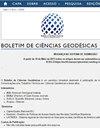电离层闪烁影响下GNSS定位性能评价
IF 0.5
Q3 Earth and Planetary Sciences
引用次数: 5
摘要
电离层不仅会降低GNSS定位的精度,而且还会降低其可用性,因为信号损失与电离层不规则性之间存在高度依赖性。地球电离层的不规则性可能产生相位和幅度的快速波动。这种快速波动被称为电离层闪烁。因此,由于衍射和折射的影响,信号可能会丢失,从而导致GNSS接收机接收到的信号减弱。因此,本文旨在通过Spearman相关分析和小波周期图,评估巴西电离层闪烁在当前太阳活动高周期(24)的幅度及其影响下的定位性能。为此,考虑了2012 - 2014年巴西3个电离层条件不同的气象站的3年时间序列,即PALM(近地磁赤道)、PRU2(赤道区和异常区)和POAL(中纬度区)的S4指数和三维MSE(均方误差)。因此,仅使用GPS卫星的C/A码就可以评价精确点定位精度与S4指数之间的相关性。结果,使用Spearman方法,PALM和PRU2系列的相关性分别为53%和51%。此外,利用小波相干性方法对空间频率与时间的关系进行分析,发现在春分和秋分月份的三维MSE最大时段,相关系数大于70%。本文章由计算机程序翻译,如有差异,请以英文原文为准。
EVALUATION OF THE GNSS POSITIONING PERFORMANCE UNDER INFLUENCE OF THE IONOSPHERIC SCINTILLATION
The ionosphere may not only degrade the accuracy of the GNSS positioning but also reduce its availability because there is a high dependence between signal losses and ionospheric irregularities. Irregularities in the Earth’s ionosphere may produce rapid fluctuations in phase and amplitude. These rapid fluctuations are called ionospheric scintillation. Thus, loss of signal can occur due to the effects of diffraction and refraction, which cause a weakening in the signal received by the GNSS receivers. In this way, this paper aims to evaluate the magnitude of ionospheric scintillation in Brazil and the performance of the positioning under its influence in the period of high solar activity in the current cycle (24), through the Spearman correlation analysis and the Wavelet periodogram. For that, three-year time series (2012 to 2014) of the S4 index and 3D MSE (Mean Squared Error) of three Brazilian stations with different ionospheric conditions were considered, PALM (near the Geomagnetic Equator) PRU2 (Equatorial region and Anomalies) and POAL (Mid-latitude region). Thus, it was possible to evaluate the correlation between the accuracy of the precise point positioning using only the C/A code of the GPS satellite and the S4 index. As a result, there was a correlation of 53% and 51%, using the Spearman method, for the PALM and PRU2 series, respectively. In addition, considering the analysis of space-frequency in relation to time by the Wavelet coherence method, a correlation of more than 70% is noted in the period of greatest 3D MSE concerning the spring and autumn equinox months.
求助全文
通过发布文献求助,成功后即可免费获取论文全文。
去求助
来源期刊

Boletim De Ciencias Geodesicas
Earth and Planetary Sciences-General Earth and Planetary Sciences
CiteScore
1.70
自引率
20.00%
发文量
10
审稿时长
3 months
期刊介绍:
The Boletim de Ciências Geodésicas publishes original papers in the area of Geodetic Sciences and correlated ones (Geodesy, Photogrammetry and Remote Sensing, Cartography and Geographic Information Systems).
Submitted articles must be unpublished, and should not be under consideration for publication in any other journal. Previous publication of the paper in conference proceedings would not violate the originality requirements. Articles must be written preferably in English language.
 求助内容:
求助内容: 应助结果提醒方式:
应助结果提醒方式:


